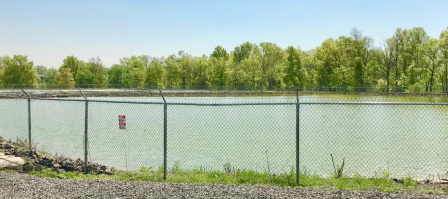News Releases from Region 02
EPA Announces $74 Million Cleanup Plan for American Cyanamid Superfund Site in Bridgewater Township, N.J.
09/28/2018
Contact Information:
(New York, N.Y. – September 28, 2018) Today, the U.S. Environmental Protection Agency (EPA) announced a $74 million final plan to clean up acid tars, benzene, and other chemicals at the American Cyanamid Superfund site in Bridgewater Township, N.J.
“The remedy selected in this Record of Decision will clean up the two most contaminated impoundments in a manner that is protective of the Bridgewater community and the workers at the site,” said Acting EPA Administrator Andrew Wheeler. “This final cleanup plan reflects our commitment to prioritize the Superfund Program and ensure these sites are cleaned up as quickly and safely as possible.”
“More than 44,000 tons of hazardous waste will be removed from the Bridgewater community and permanently destroyed. Approximately 2.3 million gallons of contaminated liquid will be collected and treated.” said EPA Regional Administrator Pete Lopez. “This action safeguards people’s health and arrests a threat to the Raritan River.”
“Bridgewater is counting on the EPA to remove these 44,000 tons of waste. These hazards need to be out of our community as soon as possible,” said Congressman Leonard Lance, federal lawmaker for Bridgewater and member of the House Energy and Commerce Committee. “I am pleased the EPA is implementing a final plan and moving forward in getting this job done. I believe the final plan to be responsible and the disposal of the approximately 2.3 million gallons of contaminated liquid will result in the contaminants’ safe removal and permanent destruction.”
Bridgewater Township Mayor Daniel J. Hayes, Jr. said, “I am happy to see that the EPA has come to a community based resolution on the two most contaminated impoundments. Public safety remains our priority. We look forward to working with our partners EPA and Pfizer on cleaning up this site.”
The final cleanup plan, called a Record of Decision (ROD), includes excavation and dewatering of contaminated material within two waste disposal areas (impoundments), followed by shipment out of the area to a facility, for treatment and disposal. Soil impacted by the impoundment contaminants will also be treated, using on-site stabilization or solidification. Surrounding “berm materials” that do not require treatment will be used as backfill, and a protective cover will be placed over the cleanup area. Measures will be taken to assure that the cleanup is undertaken in a way that is protective of workers at the site and the surrounding community.
 View of a part of the American Cyanamid Superfund Site including Impoundments 1 and 2.
View of a part of the American Cyanamid Superfund Site including Impoundments 1 and 2. (Photo credit: Courtesy of EPA)
Under the Trump Administration, the Superfund program has reemerged as a priority to fulfill and strengthen EPA’s core mission of protecting human health and the environment.
American Cyanamid Superfund site was included on the first-ever Administrator’s Emphasis List. The Administrator’s Emphasis List is composed of sites that will benefit from the Acting Administrator’s immediate and intense action. Specifically, the site was added to expedite the release of the Proposed Plan with EPA’s Preferred Alternative, which was released for public comment on May 28, 2018.
EPA held a public meeting in Bridgewater in June 2018 to explain the cleanup proposal and other options that were considered, and take public comment. The ROD officially selects the final remedy and responds directly to comments received during that comment period.
To read the EPA’s final decision, outlined in the ROD, please visit: https://semspub.epa.gov/work/02/550185.pdf or www.epa.gov/superfund/american-cyanamid
Background
The American Cyanamid Superfund Site has a history of industrial pollution dating back to 1915. For nearly 100 years, prior owners used the location for manufacturing chemicals. Several impoundments were constructed and used for waste storage and disposal throughout this period of time, which eventually resulted in the contamination of soil and groundwater with chemicals and heavy metals. The site was placed on the federal Superfund list in 1983.
In 1999, EPA removed a portion of the Superfund site from the 1983 Superfund listing, freeing it up for redevelopment and reuse. In 2012, the EPA selected a cleanup plan to address contaminated soil, groundwater and six waste disposal areas (called impoundments 3, 4, 5, 13, 17 and 24) at the site. That phase of cleanup, which is currently ongoing and being performed by Wyeth Holdings LLC, involves collecting and treating contaminated groundwater. The groundwater pump and treat system will prevent contaminated water from seeping into the nearby Raritan River, Cuckels Brook and Middle Brook.
The Superfund program has been providing important health benefits to communities across the country for more than 35 years. Superfund cleanups also strengthen local economies. Data collected through 2017 shows that at 487 Superfund sites in reuse, approximately 6,600 businesses are generating $43.6 billion in sales and employ 156,000 people who earned a combined income of $11.2 billion.
On the one-year anniversary of the EPA’s Superfund Task Force Report, EPA announced significant progress in carrying out the report’s recommendations. These achievements will provide certainty to communities, state partners, and developers that the nation’s most hazardous sites will be cleaned up as quickly and safely as possible.
EPA’s “Superfund Task Force Recommendations 2018 Update” is available at: https://www.epa.gov/superfund/superfund-task-force-recommendations-2018-update
Follow EPA Region 2 on Twitter at http://twitter.com/eparegion2 and visit our Facebook page, http://facebook.com/eparegion2.
18-075

